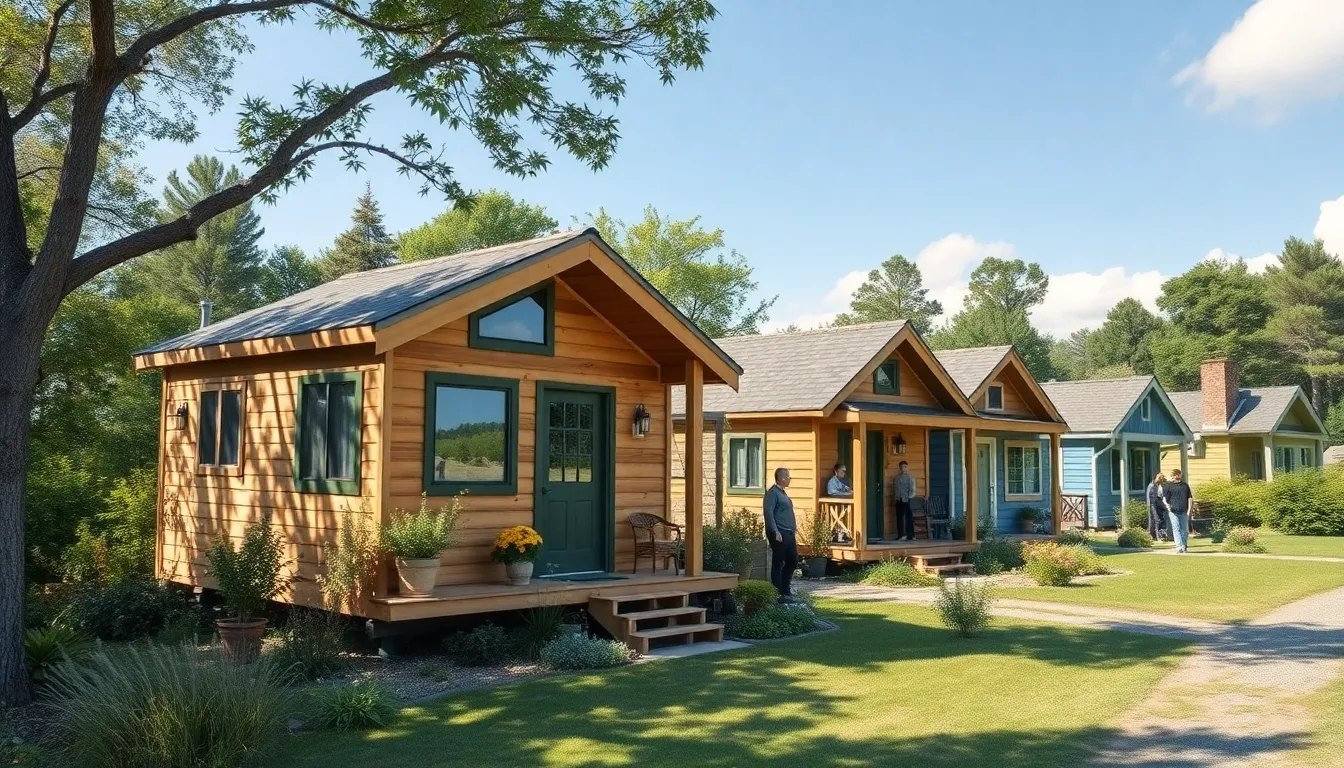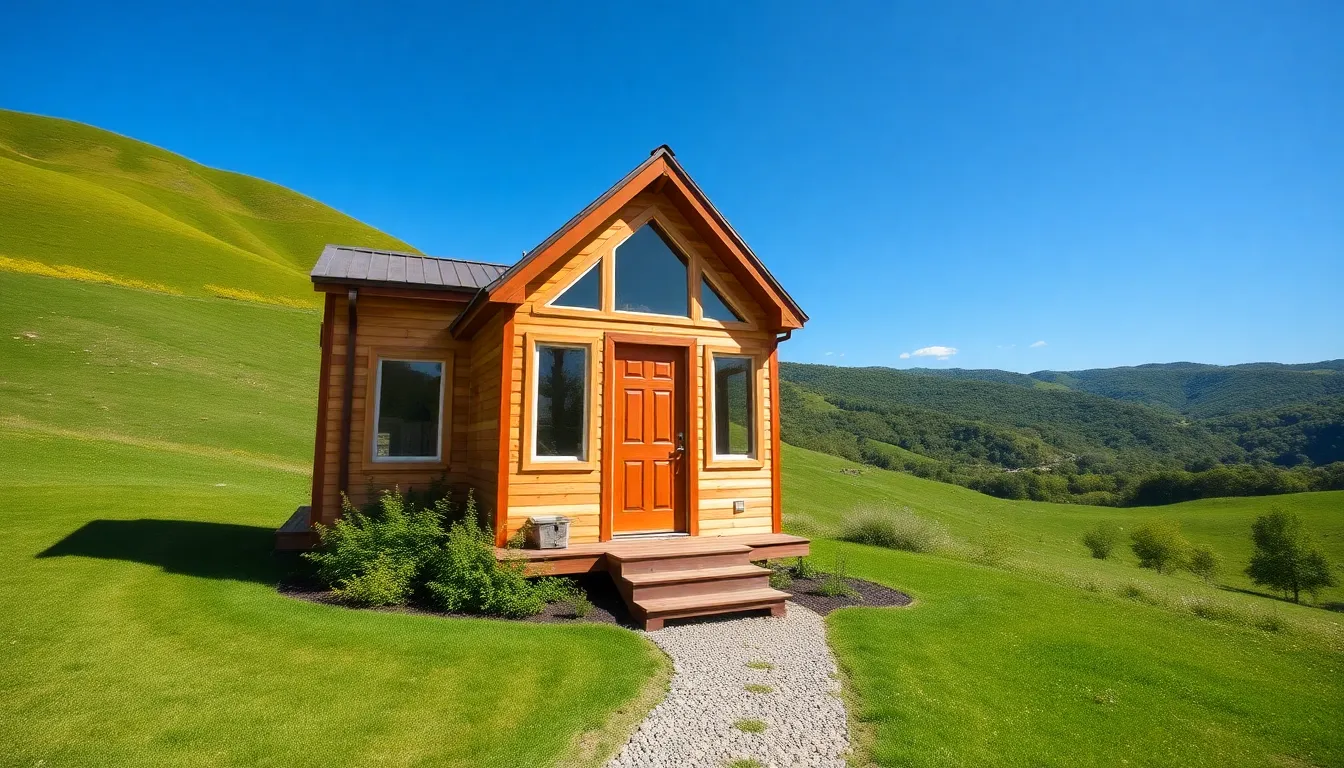Imagine a world where you can live large in a tiny house, surrounded by like-minded neighbors who share your passion for minimalism. Tiny house communities are popping up everywhere, but navigating the maze of zoning regulations can feel like trying to fit a king-sized bed into a shoebox. It’s a challenge, but the rewards are worth it.
Table of Contents
ToggleOverview of Tiny House Community Zoning
Tiny house community zoning involves various regulations governing the establishment and operation of these neighborhoods. Local governments enforce zoning laws, which often determine land use, density, and property types allowed in specific areas. Challenges arise when tiny house advocates seek to cluster homes for communal living, as typical zoning regulations focus on conventional housing structures.
Many municipalities lack clear definitions of tiny houses, leading to confusion about their legality. Some areas classify tiny houses as recreational vehicles, which can restrict permanent residency. Other regions may categorize them under accessory dwelling units, permitting a secondary housing option on existing properties. As such, local governments may impose minimum square footage requirements, complicating tiny house feasibility.
Regulatory frameworks vary significantly by location, and understanding local laws helps prevent potential roadblocks. For instance, some states have embraced tiny houses, creating supportive ordinances that encourage their development, while others remain resistant. Incentives in progressive areas may include reduced fees for permits, streamlined approval processes, or allowance within existing zoning layers.
Community engagement strengthens the case for tiny house zoning. Advocates often hold meetings to educate residents about the benefits of tiny living. Collaborating with local officials fosters understanding of tiny house concepts, helping to integrate them into existing community designs.
Ultimately, successful tiny house community zoning hinges on collaboration between residents, officials, and advocates. By addressing concerns and promoting benefits, stakeholders can work towards a shared vision that respects both community integrity and individual freedom in housing choices.
Importance of Zoning Regulations
Zoning regulations play a crucial role in the establishment of tiny house communities. They dictate land use, density, and property types, greatly impacting community viability.
Benefits for Tiny House Communities
Zoning regulations may facilitate the creation of tiny house communities by providing clear frameworks for development. They grant legal status to tiny houses, ensuring that residents can live comfortably without fear of eviction. Supportive zoning ordinances can enhance property values and establish more desirable neighborhoods. Local governments may also encourage sustainable development practices, promoting environmentally friendly living. Increased collaboration between tiny house advocates and legislators fosters an understanding of the benefits, including economic growth and community resilience.
Challenges Faced by Tiny House Developers
Tiny house developers encounter numerous challenges related to zoning regulations. Confusion around tiny house classification often leads to legal obstacles that hinder development. Many local governments impose restrictions that obstruct the establishment of tiny house communities. Navigating varying regulations from one jurisdiction to another can complicate project planning. Community opposition can arise due to misconceptions about tiny living, making education and advocacy essential for developers aiming for success.
Key Zoning Considerations
Zoning regulations significantly impact the establishment of tiny house communities. Important elements include land use and density requirements, as well as setback and building codes.
Land Use and Density Requirements
Land use designations dictate where tiny houses can be located within a jurisdiction. Communities often face strict density limits that can hinder the development of tiny house clusters. A minimum lot size and maximum unit count per acre can restrict the number of homes in a designated area. Some municipalities offer specific zoning categories or amendments to accommodate tiny homes, allowing developers to create thriving environments. Optimizing land use can enhance community sustainability and increase property values, benefiting both residents and local governments.
Setback and Building Codes
Setback requirements determine how far structures must be from property lines, influencing tiny house placement. Local building codes outline essential safety and structural regulations that tiny houses must adhere to. Flexibility in these codes can facilitate creative designs while maintaining safety standards. Some regions may allow exceptions for tiny homes, promoting innovative solutions for housing. Compliance with these regulations ensures that tiny houses align with community aesthetics and safety standards, fostering acceptance among neighbors.
Case Studies of Successful Tiny House Communities
Several successful tiny house communities demonstrate innovative zoning solutions. One example includes The Tiny House Village in Washington State. This community incorporates specific zoning ordinances that allow for tiny homes on designated parcels of land. By establishing supportive regulations, it promotes a sustainable lifestyle while addressing the need for affordable housing.
Another notable instance is Quixote Village in Olympia, Washington. This intentional community emphasizes a comprehensive zoning approach. Residents benefit from coordinated land use planning that enables the development of tiny homes while ensuring safety and infrastructure compliance. Such collaborations with local authorities enhance acceptance and facilitate project success.
Tiny House Resort in New York showcases an additional successful model. Zoning here fosters tourism and recreation while permitting tiny home rentals. Authorities recognized the economic benefits, which support local businesses and present a viable solution for affordable accommodation.
Tiny Homes ATL in Atlanta, Georgia, offers a compelling case as well. The community successfully integrates tiny homes through an innovative zoning amendment tailored for residential clusters. This adaptation illustrates how flexibility in zoning policies can address housing shortages while promoting community cohesion.
Each of these communities exemplifies how proactive zoning decisions contribute to the establishment of thriving tiny house environments. Local governments that adopt supportive regulations create frameworks for sustainable living, enhance property values, and ultimately foster vibrant, connected communities.
Future Trends in Tiny House Community Zoning
In recent years, tiny house community zoning has experienced significant evolution. Local governments increasingly recognize the demand for affordable housing solutions. As this recognition grows, more municipalities implement zoning ordinances tailored to tiny house developments.
Innovative approaches emerge in various regions. Some areas are introducing overlay zones specifically for tiny homes. These zones allow increased density and flexibility in land use, fostering more widespread adoption of tiny house communities.
Sustainability takes center stage in many zoning discussions. Many local governments prioritize eco-friendly practices, integrating sustainable infrastructure into new developments. Tiny house communities often feature shared resources, such as communal gardens or energy-efficient systems.
Public awareness drives change in zoning regulations. As understanding of tiny living increases, community advocates actively educate residents and stakeholders. These efforts facilitate collaboration with local officials, reducing misconceptions about tiny houses.
Case studies reveal promising trends in zoning adaptations. For example, jurisdictions allowing tiny homes as accessory dwelling units expand housing availability. Incentives for developers who meet specific sustainable criteria further encourage participation in tiny house initiatives.
Zoning flexibility becomes essential in addressing housing shortages. Adjustments to building codes can streamline the approval process for tiny house designs. As a result, adaptive zoning practices allow for quicker implementations, addressing immediate community needs.
Through these trends, tiny house communities demonstrate their potential to provide affordable, eco-conscious living. Forward-thinking regulations create frameworks that nourish these communities, promoting harmony between urban planning and individual housing choices.
Conclusion
Tiny house communities are reshaping the landscape of affordable living. As zoning regulations evolve to embrace this trend, the potential for sustainable and connected neighborhoods grows. By fostering collaboration among residents and local officials, communities can create frameworks that support tiny living while addressing housing shortages.
The success of these communities hinges on innovative zoning solutions that prioritize flexibility and sustainability. With increasing public awareness and advocacy, tiny house developments can thrive, offering a viable alternative to traditional housing. The future of tiny living looks promising as more municipalities recognize the value of these unique communities.







